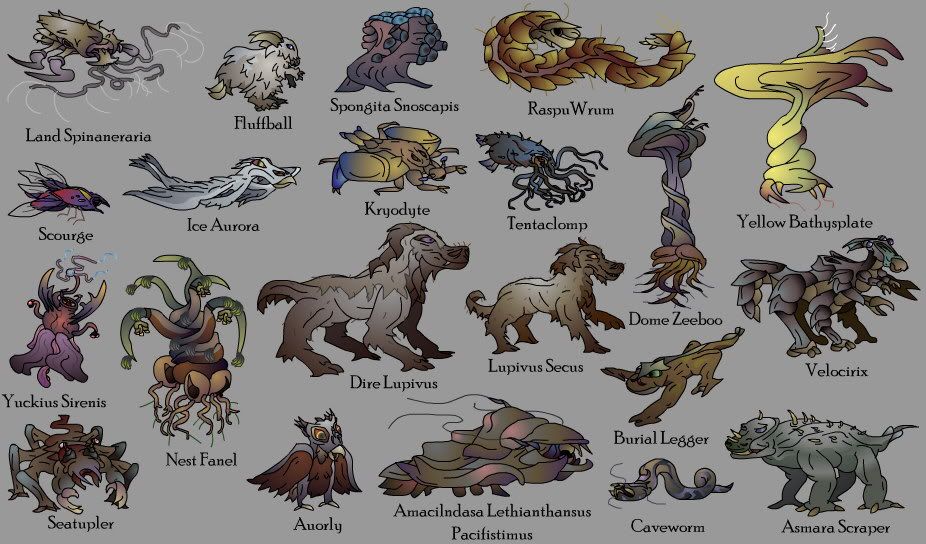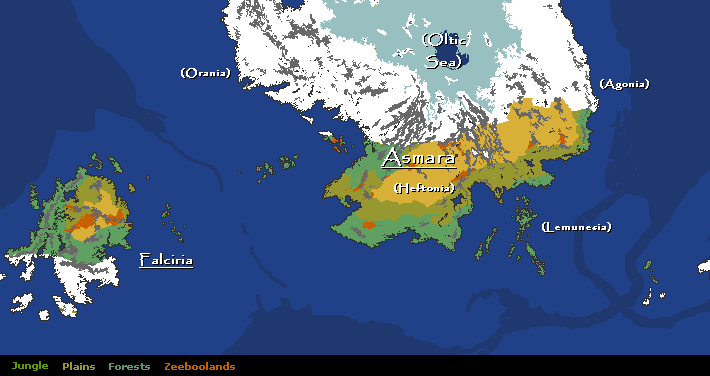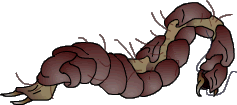Era 26: The Lupivian Era
This era is named after the Primus Lupivus, which was the most successful land predator at this time, and left behind many well-formed fossils.
The climate, which was already cold, became even colder. The Oltic Sea became fully trapped by the Asmara super-continent. The shallow coasts were home to large blooms of Cryo Bubbleo and Cryoalgae. But without ocean currents to stir up the water and supply oxygen and nutrients, the Oltic seabed became devoid of almost all life. Over millions of years, huge amounts of dead organic matter piled up on around the seabed without being decomposed by bacteria. Carbon was slowly sucked out of the atmosphere, enough to have a real impact on the climate.
Also, the collision of continents which originally formed Asmara was not quite over. More huge mountain ranges were born during this era. Glaciers followed their peaks to within a few degrees of the equator.
For those animals with little or no resistance to the cold, especially on land, there was a great shortage of habitat, and lots of competition. Only a few species were able to thrive during this era.
New Evolutions:
Planet Map:
The Air:
Climate problems were less of an issue for flying animals. The
White Aurora in particular could make epic migrations every few months. Though, competition was still fierce in most areas.
The
Royalis Jubblera soon became the most common Jubblera. Its new habit of burrowing into the ground gave extra protection from the elements as well as from predators. The Royalis is also notable as the most highly social of any animal so far, with various advantages. In particular, an attack on their nests would result in a rain of stinging acid spit, which was enough to put off all but the most desperate predator.
With eyesight specially adapted for seeing at night, the
Silver Aurora carved out a niche for itself beside all the other Auroras. Its extra feathers were probably a response to the cold, though they may also have helped with aerodynamics. It was in fact one of the most successful Auroras, rivalled only by the ocean-diving
Storm Auroras by the end of this era.
The
Temptress Fador was the most unusual of the Auroras. It is widely believed to have used strong scent glands to attract insects, and this may well have worked to help it to find food. On the other hand, it has been suggested that a nasty scent was used to deter predators and to protect vulnerable eggs from being eaten. In any case, the Temptress's greater strength seems to have been most important, both for allowing attacks on larger land animals, and for fending off attacks by rival Aurora species.
The Land: Falciria
This continent went against the global trend in some ways. Glaciers did not advance too far, and they spawned rivers from their edges which helped larger plants to finally re-colonise the interior.
Tuughwurms continued to do well here. The ancient
Leafworms were possibly extinct from both continents now, though it seems survivors were clinging on to remote islands.
By the end of this era, the
Tuughwurms had given rise to the only predator which could hunt them. The
Carniwerm was similar to the long-extinct giant worms of the past, though much better protected and able to dig much deeper. It did well feasting on Tuughwurms and the occasional Merlyte or Hiboryte which it could ambush underground, but rarely caught any other animals, mainly due to its slow speed and lack of senses.
Notable Plants:
Weak Fern, Tougher Zeeboos, Chungus, Super Lichen, Fire Moss, Buggy Moss, Parasitic Driftseed, Winter Fern
Notable Animals:
Saaranixes, Merlytes, Tuughwurms, Cephrivervalions, Rivervalions, Diggadids, Pre-Leggers, Ol Scrapers, Flevrytes, Blood Auroras, Jubbleras Sensicas, White Auroras, Silver Auroras, Carniwerms
The Land: Asmara
By the end of this era, herds of
Frozuneas and
Tundra Oltic Scrapers roamed the border of the glaciers, joining the older
Gregarix species which still survived.
Super Leggers had died out by now, handing the crown of largest land animal to the Frozunea. Frozuneas seem to have been the most succesful overall, being better adapted to the cold and able to venture further north, with the chance to nibble on the hardy Zeeboos that grew on the frozen wastes. Tundra Oltic Scrapers could at least hibernate through the worst times, as well as walk and run much faster. They were still very dumb, and their sense were still poor, but they were certainly more successful than their ancestors the
Oltic Scrapers.
As mentioned, the
Primus Lupivus was top land predator at the time, as well as the most sophisticated life form seen since the last mass extinction. It had the speed, strength, senses and brain power to take on any of the northern herd animals. Its think fur allowed to venture across most of Asmara below the glacier line, and live birth meant that their packs were more mobile instead of being stuck with eggs to guard. Though internally, the Primus's organs were still vulnerable to the cold, if it was caught in a sudden snow storm etc. Indeed, most Primus fossils seem to have come from animals that died this way.
The
Valios Polykalios was the best climber of any animal seen so far, while still being fast on the open plains. If any prey animal tried to climb a tree to escape, it would soon regret it. The Valios would have been able to feast on snoozing
Kuarytes and various other small animals. Though by the end of this era, there were only a few small pockets of suitably warm habitat left.
The
All-eater Legger had the same problem of habitat, having no resistance to the cold. It was a very versatile and successful animal wherever the climate was warm enough for it. It remained a tough target for predators. And with their swimming ability, some had made it to the remaining islands of Lemunesia, full of insects to eat.
The
Hiveworm was not the most noticeable of the new evolutions. Nonetheless it was one of the more successful species. Though hardly social enough to be called true 'hives', their scent-based groups were to be found buried amongst the forests and plains. Living underground gave some shelter from the cold, which gave them a little more habitat.
Much controversy surrounds the
Symbicus, the most unusual life form to appear for a long time. Some claim it was a truly symbiotic plant, while others claim it was just a scavenger that got a head start by attacking weak and dying animals. Any benefit it gave its 'host' would seem to have been greatly dwarfed by the host's normal food, as most plant eaters would munch their way through vast numbers of plants every day in order to survive. In any case, the fossil record shows that the Symbicus was around in some numbers, competing with the original Chungus.
Finally, the
Burrowing Zeeboo became the most successful of its kind. They were to be found defiantly growing amidst the ice and snow, and at the top of tall mountains, almost anywhere the rock surface was not buried too far down. Most of this success was owed to its ancestors, which also survived in large numbers, but its complex roots gave it the edge in the more extreme climates.
Notable Animals:
Terrarytes, Frozuneas, Gregarixes, Tundra Oltic Scrapers, Diggadids, Kuarytes, Kunatras, Hiveworms, Predarivervalions, All-Eater Leggers, Jubblerus Sensicas, Royalis Jubblera, Black Auroras, Silver Auroras, Royalis Jubblera
Notable Plants:
Burrowing Zeeboo, Mountain Zeeboos, Ice Zeeboo, Tarbanels, Winter Ferns, Novo Tranels, Tougher Zeeboos, Chungus, Woody Fanels, Weak Ferns, Super Lichen
The Oceans:
The oceans seemed to fare better than the land during this era. Sea temperatures fell only slightly compared to the land. Many species preferred the richer cold waters in any case.
Kingvalions remained top of the food chain, though their numbers were rapidly falling. Lack of tolerance for the cold was only one problem. With a lack of suitable large meals, they seem to have struggled to compete for shoals of smaller fish. Two new rival predators had appeared - the
Packtudian and the
Lordavalion.
The Packtudians were slower, especially with their large bulky claws in the way, but otherwise had few disadvantages. They were simple, social, and effective hunters of small fish. They were much more successful than the larger
Travtudian during this era.
Lordavalions, though smaller than their ancestors, were still larger than the Packtudians. Lordavalions took over as the top mid-level predator, able to eat just about everything except the Kingvalions and increasingly-rare
Yucky Sea Monsters. They were beginning to evolve resistance to cold water also.
Many ocean-floor species were still doing well. Most had hardly changed in millions of years, though the
Amacilndasa Gigantocalcis was one exception, having evolved into a fairly large and very heavily armoured creature by the end of this era. It was basically immune to attack, though that did not help it find food.
The Eferscone family was continuing to branch out. The
Strange Eferscone was another variety which ditched its exoskeleton, this time in favour of a mass of multi-purpose tentacles. It seems to have been quite successful, though not as numerous as the
Spinaneraria. The Spinaneraria had inflatable buoyancy sacs which may have helped save energy when floating near the surface, and may also have helped movement across beaches and rock pools. It was certainly a very efficient trapper of insects, with complex digestion organs to match. It was at home in ponds, lakes and rivers far inland, as well as the coast.
The same could be said of the
Predarivervalion, which was often to be found far out at sea, though it did most of its hunting by ambushing land creatures as they came to drink at rivers and water-holes. Large lungs allowed it to stay submerged for long periods, waiting for an opportunity to strike. Its reinforced skeleton and more powerful bite helped to take down prey quickly. Though, like its ancestor the
Cephrivervalion, it was limited to the warm regions of the equator.
The
Armored Amphibeel was less of a threat to land creatures, and still quite slow and awkward out of water, but it became much more widespread on land than its predecessors. Its hard and spiky scales helped to deter attack from rival predators it encountered along the way.
Meanwhile the
Algaceae Dendrotrunkis was the only sea plant to evolve during this era. It was not a huge improvement on the ancient
Algaceae Dendrocovitis species, but was soon gaining ground. Sticky seeds had evolved before, with mixed success. For now, there were enough small animals living and hiding amongst the algae for the seeds to be spread around.
Notable Animals:
Blizzardfish, Cloudfish, Panzerfish, Pondurytes, Arrow Finners, Packtudians, Lordavalions, Amacilndasa Gigantocalcis, Slimey Slugs, Mibblers, Driftworms, Bold Hunters, Shellster Gigantus, Crimson Slasheels, Voidus Garbageos, Nitros Intrepidus, Surf Auroras.
Notable Plants:
Aguaminarets, Bathyscapers, Cryoalgarp, Cyroalgae, Cryo Bubbleos, Spongita Terranovae, Spongita Wangosias, Algaceae Dendrotrunkis, Algaceae Dendrocovitis, Sea Fuzz.
Bonuses:
Plant award: Burrowing Zeeboo.
Kol.7 has +1 gene bonus.
Animal award: Packtudian.
c&civ3 has +1 gene bonus
Innovation award: Symbicus.
Lord_Iggy has +1 gene bonus
Survival award: DISABLED for now.
Story award: Lord Iggy, who already has +1 gene bonus. So
Charles Li has +1 gene bonus instead!
Problems:
@TerrisH, I think that actual hive building should be a separate gene, if there are going to be complex chambers and building of walls etc. Otherwise I assume its just digging big chambers at the moment.
@North King, I gave the Silver Aurora 'nocturnal vision', meaning extra adaptation for seeing in low light, though it doesn't add to the quality of normal vision. I think that whether or not something is a nocturnal creature should depend on its combination of genes, rather than being a gene itself.
ATTEMPTED VIOLATION: @tuxedohamm, I didn't realise until I was updating that you posted 2 separate evolutions yourself. Since I'd already drawn the Spinanera, I didn't add the Fossadid

. That was meant as a replacement after what I said about air floating? I can use that next time if you want, or it might appear as an NPC evolution.
Species Stats:









 . That was meant as a replacement after what I said about air floating? I can use that next time if you want, or it might appear as an NPC evolution.
. That was meant as a replacement after what I said about air floating? I can use that next time if you want, or it might appear as an NPC evolution. Actually no I want more of those
Actually no I want more of those  , an unlimited supply ^^
, an unlimited supply ^^ ). Instead, I'd reccomend adding x1 crawling or climbing for moving around on land, it would also go well with the tentacles.
). Instead, I'd reccomend adding x1 crawling or climbing for moving around on land, it would also go well with the tentacles.